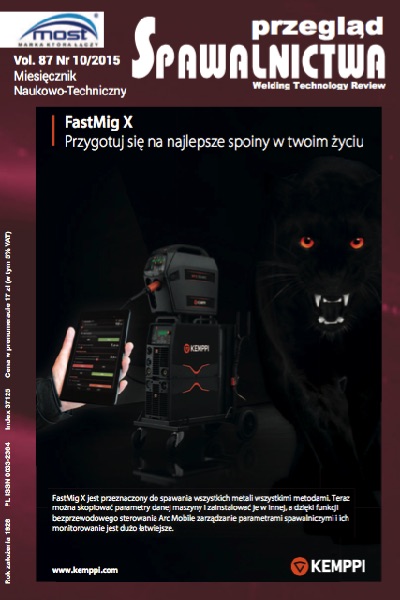Zgrzewanie rezystancyjne punktowe z pneumatycznym i serwomechanicznym dociskiem elektrod
Main Article Content
Abstract
W artykule porównano dwa systemy docisku elektrod zgrzewarki w procesie zgrzewania rezystancyjnego tj. klasyczny pneumatyczny i serwomechaniczny. Porównania dokonano na podstawie pomiarów wielkości charakterystycznych procesu tj.: prądu i napięcia zgrzewania oraz przebiegu siły docisku i przemieszczenia elektrod. Wyznaczano wielkości pochodne prądu i napięcia zgrzewania i analizowano: przebieg mocy chwilowej, rezystancji zastępczej statycznej oraz energii dostarczonej do zgrzeiny. Pomiary przeprowadzono na zgrzewarce inwertorowej dla technologicznych prób zgrzewania punktowego dwustronnego dla blach gatunku DX53 o grubości 1.5 mm z ochronną warstwą cynku. Uzyskane wyniki zweryfikowano eksperymentalnie za pomocą badań niszczących tj. statycznej próby rozciągania oraz badań metalograficznych.
Spot Resistance Welding with Pneumatic and Servomechanical Electrode Force
Abstract
The article presents the comparison of two electrode force systems applied in resistance welding machines, i.e. pneumatic (i.e. classical) and servomechanical. The comparison was based on measurements of characteristic quantities of the process, i.e. welding current and voltage as well as the force and travel of electrodes. The study involved the determination of derived quantities of welding current and voltage as well as the analyses of momentary power, static slope resistance and energy supplied to the weld. Measurements, involving the use of an inverter welding machine, were performed for technological tests of two-sided spot welding of 1.5 mm thick DX53 steel sheets provided with protective zinc coatings. The results were verified ex- perimentally in destructive tests, i.e. static tensile tests and metallographic examinations.
Downloads
Article Details
Creative Commons CC BY 4.0 https://creativecommons.org/licenses/by/4.0/
Welding Technology Review (WTR) articles are published open access under a CC BY licence (Creative Commons Attribution 4.0 International licence). The CC BY licence is the most open licence available and considered the industry 'gold standard' for open access; it is also preferred by many funders. This licence allows readers to copy and redistribute the material in any medium or format, and to alter, transform, or build upon the material, including for commercial use, providing the original author is credited.
References
Klimpel A.: Technologie zgrzewania metali i tworzyw termoplastycz- nych. Wydawnictwo Politechniki Śląskiej Gliwice 2005.
Zhang X. Q., Chen G. L., Zhang Y. S.: On-line evaluation of electrode wear by servo gun. International Journal of Advanced Manufacturing Technology, Vol 36, 2008.
HongGang Yanga, YanSong Zhanga, XinMin Lai, Guanlong Chena: An expe- rimental investigation on critical specimen sizes of high strength steels DP600 in resistance spot welding. Materials & Design, Vol 29, no. 9, 2008.
Slavick S. A.: Using serwoguns for automated resistance welding. Welding Journal vol. 78, no7, 1999.
Hana L., Thorntona M., Boomerb D., Shergoldc M.:Effect of aluminium sheet Surface conditions on feasibility and quality of resistance spot welding, Journal of Materials Processing Technology vol. 210, 2010.
Zhang X.Q., Chen G.L., Zhang Y.S.: Characteristics of electrode wear in resistance spot welding dual-phase steels. Materials and Design, vol. 29, 2008.
Mikno Z., Bartnik Z.: Projection welding with pneumatic and servo-mechanical electrode pressure system in FEM calculation - comparison. The 7th International Seminar on Advances in Resistance Welding 12-14 September 2012, Busan, Korea. Conferences materials.
Papkala H.: Zgrzewanie oporowe metali, wydawnictwo KaBe Krosno 2003.
Poradnik Inżyniera, Spawalnictwo tom 1, 2 WNT Warszawa 2005.
